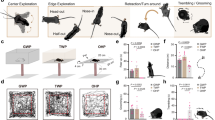Abstract
The social stress of crowding for 3, 7 and 14 days considerably reduced the increase in serum corticosterone elicited by intracerebroventricular administration of isoprenaline, a β-adrenergic agonist, on the 3rd and 7th days of crowding. The corticosterone response to clonidine, an α2-adrenergic agonist, was significantly diminished only after 3 days of crowding and this reduction was paralleled by a significant decrease in hypothalamic histamine content. The stimulatory effect of phenylephrine, an α2-adrenergic agonist, was not significantly changed by crowding stress. Social crowding stress caused almost total and persistent reduction in the hypothalamic-pituitary-adrenocortical (HPA) responsiveness to noradrenaline which stimulates the HPA axis via both α- and β-adrenergic receptors.
Similar content being viewed by others
References
C. Rivier and W. Vale,Diminished responsiveness of the hypothalamic-pituitary-adrenal axis of the rat during exposure to prolonged stress: a pituitary-mediated mechanism. Endocrinol.121, 1320–1328 (1987).
H. Anisman and R. M. Zacharko,Multiple neurochemical and behavioral consequences of stressors: implications for depression. Pharmac. Ther.46, 119–136 (1990).
M. Tanaka, A. Tsuda, H. Yokoo, M. Yoshida, K. Mizoguchi and T. Shimizu,Psychological stress-induced increases in noradrenaline release in rat brain regions are attenuated by diazepam, but not by morphine. Pharmac. Biochem. Behav.39, 191–195 (1991).
E. A. Stone and J. E. Platt,Brain adrenergic receptors and resistance to stress. Brain Res.237, 405–414 (1982).
J. Bugajski and E. Wieczorek,Social stress of crowding impairs pituitary-adrenocortical responsiveness to monoaminergic stimulation. InStress: Neuroendocrine and Molecular Approaches, (Eds. R. Kvetnansky, R. McCarty and J. Axelrod) 489–495, New York (1992).
J. Bugajski, E. Wieczorek, A. Gądek-Michalska and J. Borycz,Chronic crowding stress abolishes the pituitary-adrenocortical responsiveness to central cholinergic muscarinic receptor stimulation. Neuroendocrinol. Lett.15, 383–388 (1993).
E. A. Stone, A. V. Slucky, J. E. Platt and R. Trullas,Reduction of the cyclic adenosine 3′,5′-monophosphate response to catecholamines in rat brain slices after repeated restraint stress. J. Pharmacol. Exp. Ther.233, 382–388 (1985).
J. Bugajski, M. Turoń, A. Gądek-Michalska and J. A. Borycz,Catecholaminergic regulation of the hypothalamic-pituitary-adrenocortical activity. J. Physiol. Pharmacol.42, 93–103 (1991).
Author information
Authors and Affiliations
Rights and permissions
About this article
Cite this article
Bugajski, J., Gądek-Michalska, A., Borycz, J. et al. Effect of crowding on corticosterone responses to central adrenergic stimulation. Agents and Actions 41 (Suppl 1), C73–C74 (1994). https://doi.org/10.1007/BF02007773
Issue Date:
DOI: https://doi.org/10.1007/BF02007773




